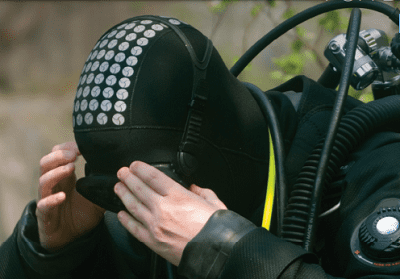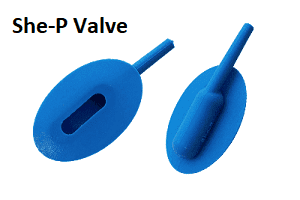Home › Diving › Equipment › Wetsuits › Medical Considerations with Dry Suits
Drysuit Diving: Common Health Concerns
Compared to standard neoprene wetsuits, diving in a dry suit has some obvious benefits, such as keeping you dry and helping you stay warmer - through a combination of undergarments.
Nonetheless, it is important to be aware of several common medical considerations and health concerns related to drysuit scuba diving.
List of Medical Concerns for Drysuit Divers
Buoyancy: Weighting, Inversion, Inflation, Flooding
The best way to improve your buoyancy for scuba diving (in any kind of exposure suit) is to have proper weighting.
As a result, being properly weighted reduces the need to add air (or vent it) to and from your dry suit.
The PADI® Dry Suit course teaches you how to use the garment as the primary device of buoyancy control. Doing so reduces the need for you to use the dry suit as a buoyancy compensating device (BCD).
Even though you will be wearing a BCD (e.g. for flotation at the surface and as a backup), adjusting the air inside the dry suit is the preferred method - especially during ascents.
Buoyancy Problems for Drysuit Divers
Inversion (the experience of being turned upside down) can occur when there is an accumulation of gas in the legs of the dry suit. Despite being a rare occurrence, it can create unwanted positive buoyancy - which may also lead to an uncontrolled ascent.
In general, proper weighting will prevent the likelihood of suffering drysuit inversion. But, wearing elastic straps or gaiters may also help to reduce gas migration to the lower leg sections.
Diving in a bit deeper...
Sometimes, a drysuit inflator valve can get stuck in the open position. If this happens, it can result in problematic inflation. Using the dump valves (or detaching the inflator hose) will help to neutralise the air flow and remedy the situation.
So, what can drysuit divers do if they are experiencing buoyancy problems and are unable to correct them? First, flaring the body helps to slow down a rapid ascent.
It is also important to minimise the risk of barotrauma injuries in scuba diving by staying calm and controlling your breathing.
Also, it's not uncommon for a dry suit to flood with water (e.g. from a blown neck seal). In general, this would not create a scuba emergency - unless you happened to be diving in contaminated water.
Important: Divers should end the dive as safely as possible (using the backup BCD) if they experience a flooded dry suit.
Constriction: Hand Numbness and Carotid Sinus Reflex
Drysuit Wrist Seals
Even though you want the seals to fit snug around your neck and wrists - and be watertight - they should not feel too constrictive. Having the wrist seals too tight can restrict normal blood flow, which may also lead to:
- A loss of dexterity (e.g. unable to perform simple tasks)
- Increased susceptibility to hypothermia (cold injuries)
- Pain, numbness, or tingling sensations in your hands and fingers
Neck Seals on Dry Suits
A condition called carotid sinus reflex can result from having the neck seal too tight on a dry suit. This is one of the most serious medical considerations for drysuit divers to be aware of.
Carotid sinus hypersensitivity leads to a severe slowing of the heartbeat and a reduction of blood flow to the brain. In most cases, divers who have the drysuit neck seal too tight will feel:
- Dizzy
- Lightheaded
- Reduced consciousness
Tip: You can prevent over constriction (excessive tightening) from dry suit seals by applying appropriate trimming techniques and by stretching the seals before use.
Dermatological Issues: Rashes, Bruising, and Skin Bends
When you first start scuba diving in a dry suit you should be aware about certain conditions that can lead to skin irritation.
In short, dry suit seals made of latex are the ones that result in diving-related skin conditions most often. Thus, divers with sensitive skin may find using gel-type seals - or those made of neoprene or silicone - will reduce the irritations.
Furthermore, you can get skin chafes from an ill-fitting dry suit. Some divers will use barrier creams to protect the skin from chafing at the main contact areas (e.g. wrists and neck).
Causes of Drysuit Squeeze
Failing to add enough air inside a suit during descent is the most common reason for a squeeze. Drysuit squeezes (e.g. skin bruising) occurs most often behind the valves and the seams of the garment.
Skin Bends (Mild DCS)
Beginners often confuse common drysuit rashes, chafing, and bruises with some of the more severe diving-related skin conditions. Simply put, it is a mild form of decompression sickness (DCS) that causes blotchy, bruise-like skin bends.
The rash usually shows up on areas where we have most body fat or adipose tissue (e.g. the abdomen, buttocks, breasts, and thighs).
Drysuit divers should also be aware that other signs and symptoms often accompany skin bends, including:
- Deep-tissue soreness or tenderness.
- DCI neurological symptoms (e.g. dizziness, blurred vision, memory impairment, severe fatigue).
As a result, it is important to recognise the symptoms of skin bends and not delay professional evaluation. Always seek prompt medical attention from a diving physician if you develop any skin lesions after a dive (e.g. phone the DAN EMERGENCY HOTLINE NUMBER).
Note: Divers Alert Network (DAN) statistics show that around 20% of scuba divers who experience skin bends also go on to develop some accompanying neurological symptoms.
Thermal Issues with Dry Suits
It is important to use insulated and electrically heated garments in the proper manner when diving in a dry suit to get optimum protection from adverse underwater conditions.
 Thus, you will need to wear three (3) garment layers to get effective thermal protection. Each layer provides a different function:
Thus, you will need to wear three (3) garment layers to get effective thermal protection. Each layer provides a different function:
- Base layer: Usually made of polyester or polypropylene to move moisture away from the skin to prevent heat loss (e.g. via conduction).
- Insulating layer: Merino wool, microfiber, fleece, or other materials trap and hold heat to reduce heat loss through conduction.
- Shell: The membrane, neoprene or hybrid holds air to further reduce conductive and convective heat loss.
Drysuit divers adjust their thermal protection according to the kind of dive undertaken. Hence, they will consider several factors before choosing the weight of the insulating layer, including:
- Anticipated activity level
- Metabolic rate
- The water temperature
You can get additional thermal protection by wearing electrically heated garments. They can enhance your comfort underwater. But, they can also increase the risk of DCS if used incorrectly.
According to Divers Alert Network (DAN) guidelines, to lower the risks of decompression stress you should:
Leave heated garments off or at the lowest setting during the descent and bottom phase. Doing so will minimise the increase in inert gas uptake.
Then, increase the setting modestly for the ascent and stop phase. This encourages inert gas elimination without excessive promotion of localised overheating that can promote bubble formation and other skin symptoms.
Choosing the most appropriate scuba diving gloves for the dive site is another important factor for beginners to consider.
As a rule of thumb, you will need to find a healthy balance between thermal protection and the reduced dexterity that they offer.
Note: Another section contains a scuba wetsuit temperature guide with data that explains the thermal protection qualities and suitability for use underwater.
Urological Considerations for Urinating Underwater
Because it is more complicated for drysuit divers to urinate underwater, you need to understand how the P-valve system works.
 P-valve systems include 'sex-specific' collection devices. They contain a tube that sends urine into surrounding waters. So, you need to put the unit on before you don the dry suit.
P-valve systems include 'sex-specific' collection devices. They contain a tube that sends urine into surrounding waters. So, you need to put the unit on before you don the dry suit.
Some of the common medical issues for drysuit divers who need to use a pee-valve system (e.g. on a long dive) may include:
- Pneumaturia (passing air into the bladder during urination)
- Urogenital infections
- Genital squeeze (also called a catheter squeeze)
If air or gas bubbles pass into the urethra - either before or after urination - it can lead to a health condition called pneumaturia. It may produce a burning sensation or it may halt the normal urination process altogether
Moreover, inadequate cleaning of the P-valve tubing may cause a range of urogenital infections. Nonetheless, using a balanced P-valve system with one-way check valves helps to reduce the likelihood of urinary infections.
Balanced P-valve systems also help to prevent genital squeeze. This is a condition caused by a depth-related drop in the capacity of the tubing in unbalanced systems.
Important: Using general post dive hygiene, and disinfecting the P-valve system after each use, helps to reduce urogenital infections.
Related Information and Help Guides
Note: The short video (4:14 seconds) presented by DAN explains more about dry suit and undergarment configurations.